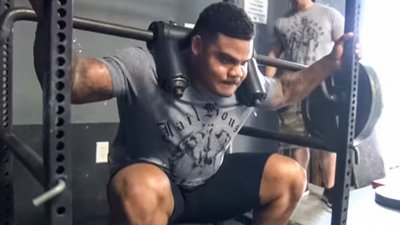What good is it to have an upper body that looks like Tarzan's but a lower body that resembles a chimp's?
If you have the desire for leg growth and are willing to put in the work—and be prepared, this isn't going to be easy—I've got the four game-changing exercises that'll help you maximize lower-body hypertrophy. I'll bet you haven't seen anything like these movements before, so be prepared for an overwhelming lower-body training stimulus.
We're starting with hamstrings, because all too often, they're an afterthought in your leg training. Let's go.
1. Band-Resisted Romanian Deadlift
For maximum hamstring development, you must include exercises that require movement at the knees (knee flexion) and hips (hip extension) in your workout. Don't just use exercises in which you bend at the knees, like leg curls. Many explosive athletes, in fact, feel hip extension is the most important movement pattern in all of sport. With that in mind, let's untap the keg at this thigh-building hootenanny with some band-resisted Romanian deadlifts, which engage the hip extensors.
About the Movement
The hamstrings are primarily a fast-twitch muscle group. This is why explosive athletes, like sprinters, have greater hamstrings development than even the most muscular athletes in the world, bodybuilders.
Sprinters train the hamstrings in short, explosive bursts; on the other hand, bodybuilders do way too many sets and reps, and they don't use very heavy weights.
Legendary martial artist and actor Bruce Lee learned fencing to increase his hand speed; that's the same cross-disciplinary example you're going to follow and train hamstrings like an athlete. With this in mind, we know hamstrings respond best to lower reps, heavier weights, eccentric overloads, and explosive concentrics.
Before you start this exercise, you need to attach bands safely to a barbell. This is done by looping one band on each side of the barbell and attaching the other side to a low-lying anchor point; this can be dumbbells, the bottom of a power rack, or on a platform with pegs. With bands attached, the weight will be heavier at the top of the range of motion whether you're doing positive or negative reps.
Do It Right
Start this movement in the standing position. Take a stance between hip and shoulder width; grasp the bar with a pronated grip (palms down) with your hands right outside of your thighs.
Keep your knees slightly bent and your back flat. Lower the bar while keeping your chest up by pushing your hips back and purposely putting tension on the hamstrings. Stop at mid-shin level (your torso should be about parallel to the floor). Lift the weight to the starting position by forcefully extending your hips, pushing them strongly forward. Keep the bar in close to your body; the further it drifts away from you, the more stress your lower back endures.
Training Tips
- Perform this movement heavy but never at the expense of sacrificing technique or tension. Do 3 sets of 6 reps using a controlled, steady-paced eccentric of 5 seconds followed by a forceful contraction on the concentric portion of the movement.
- Use straps if necessary.
- Whatever bar weight you're training with, you'll want to add an additional 10-25 percent band resistance to the barbell. Keep in mind that bands cause an overspeed effect on the eccentric portion of the lift, so couple this with a 5-second negative. Combined with the explosive concentric, the hamstrings are under extreme training duress, so lapses in technique not only compromise results but could land you in the ER.
Bonus Tip: If you have only one band, step on the middle of that band, and loop both ends evenly around the bar.
2. Eccentric-Overload Leg Curl (2 Up/1 Down)
Now that you've blasted your hamstrings from the hips, let's turn our attention to targeting them with knee flexion.
About the Movement
Here's another example of taking a good movement and making it great. Scientists, bro scientists, glossy muscle mags, and textbooks agree: You're stronger eccentrically than concentrically. How much varies, but I've seen studies that show anywhere from 20-70 percent stronger. Consider this an opportunity you've likely never exploited!
Do It Right
Use a weight equivalent to your 12-repetition max with two legs on a lying leg curl. Start by curling the weight up with both legs, then let the weight down with only one leg using a steady 5-second negative. Repeat in alternating fashion, doing 3 reps on each side for 3 sets.
Bonus Tip: No leg curl? Give Nordic leg curls (also known as floor glute-ham raises) a shot.

3. Eccentric/Isometric Machine Pause Squats
Now that the back of your legs are finished off, it's time to "quad bless" you!
About the Movement
You want to know what anal-retentive paranoia is all about? Then watch how some bodybuilders never budge from their training routine of 3 sets of 10-15 reps, with no attention ever paid to eccentric or isometric contractions.
We don't care about the establishment—we care about results!
Do It Right
This movement can be performed on any type of squat machine. You'll perform all repetitions with a full range of motion for 3 working sets of 6 repetitions. But these aren't just regular milk-toast reps.
- Stop one-third of the way down, and pause isometrically for 3 seconds.
- Stop two-thirds of the way down, and pause isometrically for 3 seconds.
- Pause for 3 seconds at the bottom of the movement.
- Forcefully go into the concentric portion back to the starting position.
Overload is hellacious on this exercise. Over the total of 6 repetitions, you'll pause 54 seconds isometrically, and you'll also have to precisely control the eccentric between stopping points. It doesn't end there, as muscle tension is maximized on the way up by performing the movement as explosively as possible.
In that one set, all three types of contractions (eccentric, concentric, isometric) are overloaded. If this isn't a recipe for hypertrophy, I don't know what the hell is.
No squat machine? No problem. Do these on a leg press.
Bonus Tip: If glory on the gridiron as a lineman is your objective, try this same movement—but pause instead at the same spots on the concentric. This is a very similar to overcoming a stalemate on the line of scrimmage.
4. Hatfield Overload Squat
In the past, squatting's effectiveness for hypertrophy was limited by your sticking point, but not any longer!
About the Movement
Fred Hatfield, affectionately known by his fans as "Dr. Squat," set numerous world records in the squat. Back in the day he also trained champion athletes like boxer Evander Holyfield and bodybuilder Lee Haney, as well as former gridiron great Lyle Alzado. Because of Hatfield's endorsement of the safety bar, in many circles, the bar is simply called the "Hatfield bar." Squats performed with this bar are known as Hatfield squats.
Hatfield has personally mentored me, and today, we do seminars together all around the world. I'm a firm believer in this movement, and so are my clients!
Perform Hatfield overload squats by grasping the handles or uprights in the power rack. The heavy weights strong athletes must use to maximize muscular overload while squatting can cause the back to round or otherwise put too much stress on it while shortchanging the intended target, the thighs.
Hatfield squats damn this muscle-building conundrum to hell, because you apply pressure against the power rack by grabbing the handles, and this forces you to squat with a straight back the entire movement. Your hands serve as self-spotters, so you won't drift outside of the ideal groove. Furthermore, when you encounter a sticking point, you simply pull through with just enough pressure to overcome it, so muscular overload is maximized, not limited by a sticking point.
There are other advantages, such as less discomfort on the elbows, shoulders, and wrists, not to mention the pad adding a greater element of comfort. Hatfield overload squats allow you to adapt squats to fit your own body.
Perform this movement for 3 sets of 15 reps.
Bonus Tip: If you only have a straight bar at your disposal, perform this heavy for 3 sets of 1-5 reps.
You can put all four movements together in a single workout for an incredible change of pace from what you normally do.



